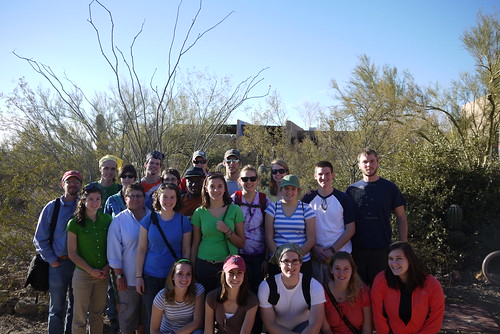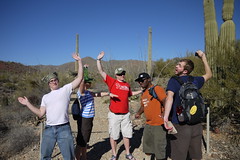 I think I speak for everyone in the group when I say that the past few days have just been a whirlwind of stories, facts, beauty, hard truths, and more. The main events have been making our way through air travel, touring a US Department of Homeland Security Immigration and Customs Enforcement detention center (in Florence, AZ), hearing from Kara Hartzler, legal director of the Florence Project (helping with legal representation for detained persons), speaking with members of Shalom Mennonite Congregation in Tucson, and touring the Arizona-Sonora Desert Museum. Yeah, it’s been busy.
I think I speak for everyone in the group when I say that the past few days have just been a whirlwind of stories, facts, beauty, hard truths, and more. The main events have been making our way through air travel, touring a US Department of Homeland Security Immigration and Customs Enforcement detention center (in Florence, AZ), hearing from Kara Hartzler, legal director of the Florence Project (helping with legal representation for detained persons), speaking with members of Shalom Mennonite Congregation in Tucson, and touring the Arizona-Sonora Desert Museum. Yeah, it’s been busy.
Our tour of the detention center was thorough… but also one-sided. We were shown what the process was supposed to look like when things ran smoothly. We had been primed with some pretty awful stories of when things went wrong, so hearing how things are supposed to go was a pleasant surprise in a couple ways. One thing to note is that we often associate ICE detention centers with individuals who have entered the country without proper documentation. However, the majority of the detainees at this facility were individuals who did have some legal status (permanent residence, green card, etc.) but had committed some crime (such as possession of drug paraphernalia) for which they could be punished by deportation. Here is a brief summary of people’s reactions to the ICE detention center tour:
- Surprised at the physical proximity to the detainees (we were in the same room as detainees at a couple points)
- Surprised we actually got to see much of the facility
- Surprised by how nice it was (except the beds)
- Surprised by the good quality of the medical facilities
- Surprised by the quick turnover rate (they have 300-some beds, but over the course of last year 45,959 detainees passed through center)
- Surprised by the difference between illegal entrants whose only crime was illegal entry and legal residents who had committed a crime
Kara Hartzler told a different story. She told us about many cases that were the exceptions when the process didn’t go smoothly, mistakes were made, individuals rights were trampled, and justice was not served. These stories, though rare, can deeply impact individual’s and families’ lives. In my opinion, Kara’s presentation was just as one-sided as the ICE officials’. These sides were so complementary, though, that they both made perfect sense.
We rounded out our day with some ice cream and then an evening with some members of Shalom Mennonite Church back in Tucson. These individuals told us many stories of the ways they encounter immigrants, their views on the Mennonite Church USA’s convention being held in Arizona, and outcomes of the new AZ immigration legislation (SB 1070). It was interesting to see how on each of these issues there was disagreement and conversation within the church. Not everyone was of one mind, but they were still working together and continuing to search for what it means to be church in this area of the world.
One thing that stood out to at least a couple students was the fact that racial profiling inherent in immigration law scares all immigrants whether they are citizens, legal residents, or undocumented immigrants. Latino people are pulled over more and basically have to carry documentation with them. Even with documentation, though, they can still be accused of stealing that documentation… so there’s no way to really feel safe if you’re of Latino heritage. This particularly strikes me because as a Caucasian person I have immense privilege and can never really understand the fear or frustration that these Latinos are feeling.
This encounter with people trying to do church here in Tucson really brought home for me the strength that our Christian faith can be. We have something incredible to bring to this situation and I hope that through this trip I can remember that faith grounding and listen to what that faith has to say about the situation.
Overall, the various presentations yesterday helped educate us about immigration. The different presenters helped show us the real complexity of the situation and the humanity and truth on all sides. We did a lot of sifting through personal bias (both the presenters and our own), but through it all we began to really enter in to this border area.
 One last thing to note is just the landscape here in southern AZ. We are in a desert. This place is unlike anything I have ever seen and I am just amazed by it. I’m sure the rest of the group is getting tired of me saying so, but it’s just amazing! You can see for miles with no large trees to block your view and it seems like every way you look you can see mountains in the distance. The sharp, scrubby plants in the foreground blend into a carpet until rocks seem to erupt through this carpet and form mountains in the distance. The sun is blinding and warms you right up, but the wind gets chilly when you’re in the shade. Everyone looks extra beautiful with the wind in their hair and the sun on their faces. This is not a sand dune sort of desert… it’s just something else. Also, there are cacti everywhere.
One last thing to note is just the landscape here in southern AZ. We are in a desert. This place is unlike anything I have ever seen and I am just amazed by it. I’m sure the rest of the group is getting tired of me saying so, but it’s just amazing! You can see for miles with no large trees to block your view and it seems like every way you look you can see mountains in the distance. The sharp, scrubby plants in the foreground blend into a carpet until rocks seem to erupt through this carpet and form mountains in the distance. The sun is blinding and warms you right up, but the wind gets chilly when you’re in the shade. Everyone looks extra beautiful with the wind in their hair and the sun on their faces. This is not a sand dune sort of desert… it’s just something else. Also, there are cacti everywhere.
We are leaving tomorrow to stop by Nogales and walk across the border and back and then continue on to Douglas/Agua Prieta where we will be staying for the next week. Agua Prieta is at a higher elevation than Tucson and they’ve been well under freezing the past few nights, so we’ll all be pulling out the under armor.
We appreciate your prayers as we continue to enter into this place and experience the complexities and frustrations as well as the beauty.
-Rose Byler